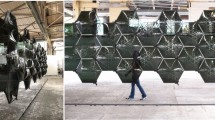Abstract
A visual language for designs of acoustical arrays is defined by a shape grammar that deploys design rules using shape representations of acoustic panels with labels and weights to specify known formal and performative information. Reciprocal 3-D acoustic plots are computationally simulated using a perfectly matched layer finite element method and inform how the interactions of invisible sound waves are impacted by visual design decisions. This paper presents the results of this framework with 3 × 3 arrays of diffusers and absorbers, resulting in the introduction of an aesthetic value \(~\bar{E}\), incorporated with the diffusion coefficient, allowing for nuanced objective performative evaluation of these arrays. This ultimately leads to creative visual expressions of design rooted in acoustic theory and performance.









Similar content being viewed by others
References
Agarwal, Manish, Jonathan Cagan, and George Stiny. 2000. A Micro Language: Generating MEMS Resonators by Using a Coupled Form-Function Shape Grammar. Environment and Planning B: Planning and Design 27 (4):615-626. https://doi.org/10.1068/b2619.
Bradley, David, Erik Snow, Kimberly Riegel, Zachary Nasipak, and Andrew. Terenzi. 2011. Numerical prediction of sound scattering from surfaces with fractal geometry: A preliminary investigation. Proceedings of Meetings on Acoustics 12(1): 015010. https://doi.org/10.1121/1.4862555.
Cox, Trevor J. 1995. The optimization of profiled diffusers. The Journal of the Acoustical Society of America 97 (5):2928-2936.https://doi.org/10.1121/1.412972.
Cox, Trevor J., and Peter D’Antonio. 2016. Acoustic Absorbers and Diffusers: Theory, Design and Application, 3rd ed. Taylor and Francis.
Duarte, José Pinto. 2005. Towards the Mass Customization of Housing: The Grammar of Siza’s Houses at Malagueira. Environment and Planning B: Planning and Design 32 (3):347-380. https://doi.org/10.1068/b31124.
Grasl, Thomas, and Athanassios Economou. 2018. From shapes to topologies and back: An introduction to a general parametric shape grammar interpreter. Artificial Intelligence for Engineering Design, Analysis and Manufacturing 32:208-224. https://doi.org/10.1017/S0890060417000506.
ISO. 2012. ISO 17497–2:2012(en): Acoustics — Sound-scattering properties of surfaces — Part 2: Measurement of the directional diffusion coefficient in a free field. Geneva, Switzerland: International Organization for Standardization.
Järvinen, Antti, Lauri Savioja, and Kaarina Melkas. 1998. Numerical simulations of the modified Schroeder diffuser structure. Journal of the Acoustical Society of America 103:3065-3065.
Lee, Juney. 2015. Grammatical Design with Graphic Statics: Rule-based Generation of Diverse Equilibrium Structures. Master’s thesis, MIT.
Ligler, H. and Economou, A. Entelechy Revisited: On the generative specification of John Portman’s architectural language. Environment. and Planning B, 45(4): 623-648. https://doi.org/10.1177/0265813516676489
Long, Marshall. 2014. Architectural Acoustics, 2nd ed. Elsevier Science.
March, Lionel. 2011. Forty Years of Shape and Shape Grammars, 1971-2011. Nexus Network Journal 13 (1):5-13. https://doi.org/10.1007/s00004-011-0054-8.
McCormack, Jay P., Jonathan Cagan, and Craig M. Vogel. 2004. Speaking the Buick language: capturing, understanding, and exploring brand identity with shape grammars. Design Studies 25 (1):1-29. doi:https://doi.org/10.1016/S0142-694X(03)00023-1.
Mitchell, William J. 1991. Functional grammars: An introduction. In: Reality and Virtual Reality (ACADIA Conference Proceedings / ISBN 1-880250-00-4), eds. Glenn Goldman, G. Zdepski, and M. Zdepski, 167–176. Troy, NY: ACADIA. http://papers.cumincad.org/cgi-bin/works/Show?eae1.
Schroeder, Manfred. 1975. Diffuse sound reflection by maximum length sequences. Journal of the Acoustical Society of America 57:149-150.
Smith, Eric. 2004. Practical Guidelines For Constructing Accurate Acoustical Spaces Including Advice On The Proper Materials To Use. Auralex Acustics.
Stiny, George. 1976. Two Exercises in Formal Composition. Environment and Planning B: Planning and Design 3 (2):187-210. https://doi.org/10.1068/b030187.
Stiny, George. 1980. Introduction to Shape and Shape Grammars. Environment and Planning B: Planning and Design 7 (3):343-351. https://doi.org/10.1068/b070343.
Stiny, George. 2006. Shape: Talking about Seeing and Doing. MIT Press
Stiny, George, and James Gips. 1972. Shape Grammars and the Generative Specification of Painting and Sculpture. Presented at IFIP Congress 71 in Ljubljana, Yugoslavia. In: Information Processing 71, C. V. Freiman. ed., 1460–1465. Amsterdam: North-Holland.
Stiny, George, and James Gips. 1978a. Algorithmic Aesthetics: Computer Models for Criticism and Design in the Arts.
Stiny, George, and James Gips. 1978b. An Evaluation of Palladian Plans. Environment and Planning B: Planning and Design 5 (2):199-206. https://doi.org/10.1068/b050199.
Stiny, George, and William Mitchell. 1978. The Palladian Grammar. Environment and Planning B: Planning and Design 5:18 - 15.
Von Neumann, J. and Burks, A.W. Eds. Theory of Self-Reproducing Automata. Champaign, IL: University of Illinois Press, 1966.
Yavuz, Ecenur, Birgül Çolakoğlu, and Begüm Aktaş. 2018. From pattern making to acoustic panel making using shape grammars. Presented at eCAADe (Education and research in Computer Aided Architectural Design in Europe), Lodz, Poland. In: Shape, Form & Geometry | Applications, vol. 2, eCAADe 36: 477–486.
Zampolli, Mario, Alessandra Tesei, Finn B. Jensen, Nils Malm, and John B. Blottman III. 2007. A computationally efficient finite element model with perfectly matched layers applied to scattering from axially symmetric objects. The Journal of the Acoustical Society of America 122 (3):1472. https://doi.org/10.1121/1.2764471.
Acknowledgements
All images are by the authors. The authors would like to thank Elijah Racz, from Indiana University – Purdue University Indianapolis for his work with the acoustic simulations.
Author information
Authors and Affiliations
Corresponding author
Additional information
Publisher's Note
Springer Nature remains neutral with regard to jurisdictional claims in published maps and institutional affiliations.
About this article
Cite this article
Dessi-Olive, J., Hsu, T. A Simulation-Validated Shape Grammar for Architectural Acoustics. Nexus Netw J 24, 55–73 (2022). https://doi.org/10.1007/s00004-021-00583-8
Accepted:
Published:
Issue Date:
DOI: https://doi.org/10.1007/s00004-021-00583-8




